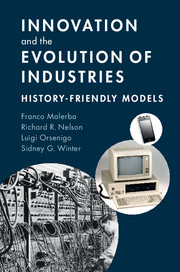Book contents
- Frontmatter
- Contents
- List of figures
- List of tables
- Preface and acknowledgments
- Codes
- Some remarks about notation
- 1 Innovation and industrial evolution
- 2 History-friendly models: methods and fundamentals
- 3 The US computer industry and the dynamics of concentration
- 4 Vertical integration and dis-integration in the computer industry
- 5 The pharmaceutical industry and the role of demand
- 6 Reprise and conclusions
- References
- Author index
- Subject index
3 - The US computer industry and the dynamics of concentration
Published online by Cambridge University Press: 05 August 2016
- Frontmatter
- Contents
- List of figures
- List of tables
- Preface and acknowledgments
- Codes
- Some remarks about notation
- 1 Innovation and industrial evolution
- 2 History-friendly models: methods and fundamentals
- 3 The US computer industry and the dynamics of concentration
- 4 Vertical integration and dis-integration in the computer industry
- 5 The pharmaceutical industry and the role of demand
- 6 Reprise and conclusions
- References
- Author index
- Subject index
Summary
INTRODUCTION
In this chapter we develop a history-friendly model of the development of the US computer industry in the latter half of the twentieth century. The history is marked by a pattern of emergent concentration and subsequent de-concentration, from the industry's birth based on mainframe computers through the advent of personal computers (PC). Our principal analytical purpose in the chapter is to illuminate the explanation for this pattern. We begin in Section 3.2 by laying out the relevant features of that history, the appreciative theorizing about that history and the challenges for history-friendly modeling. In Section 3.3 we develop the model. In Sections 3.4 and 3.5 we display some history-replicating and history-divergent simulations and discuss the major factors affecting the specific evolution of the computer industry and competition among firms. In Section 3.6 we draw our conclusions.
THE EVOLUTION OF COMPUTER TECHNOLOGY AND THE COMPUTER INDUSTRY
A stylized history
A detailed recounting of the industry's history is beyond the scope and purpose of this chapter. We offer only a stylized history of computer technology and the industry, drawing from Flamm (1988), Langlois (1990), Bresnahan and Greenstein (1999) and especially Bresnahan and Malerba (1999).
The computer industry's history shows continuous improvements in machines that serve particular groups of users, punctuated from time to time by the introduction of significant new component technologies that permit the needs of existing users to be better addressed, but also open up the possibility of serving new market segments. In the United States these punctuations were associated with the entry of new firms, which almost always were the first to venture into the new market. However, this happened to a significantly lesser degree in Europe, and hardly at all in Japan.
The evolution of the industry divides naturally into four periods. The first began with the early experimentation, which culminated in designs sufficiently attractive to induce large firms with massive computation tasks, as well as scientific laboratories, to purchase computers. This opened the era of the mainframes. The second period began with the introduction of integrated circuits and the development of minicomputers. The third era is that of the PC, made possible by the invention of the microprocessor.
- Type
- Chapter
- Information
- Innovation and the Evolution of IndustriesHistory-Friendly Models, pp. 43 - 92Publisher: Cambridge University PressPrint publication year: 2016

